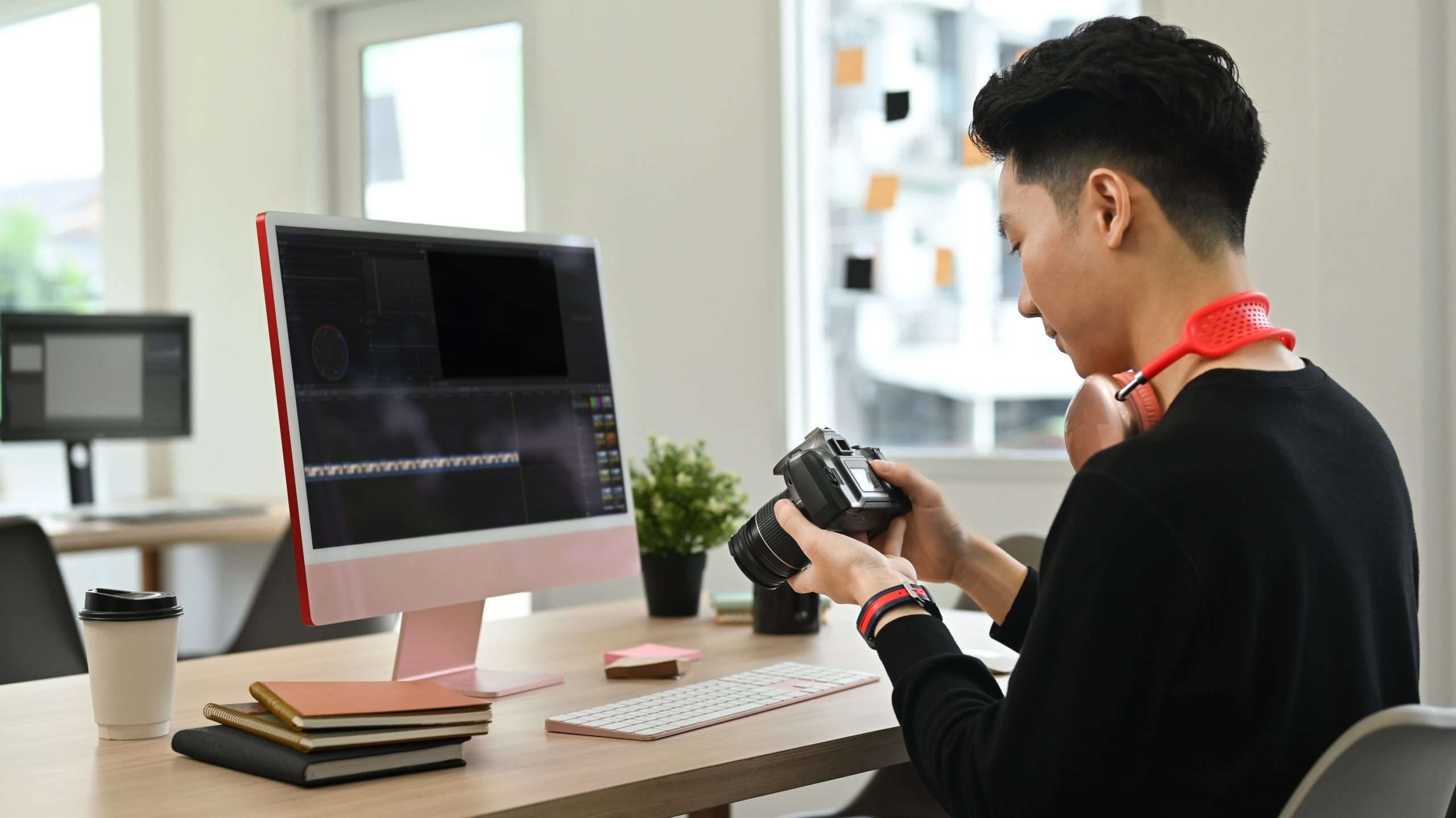 Embarking upon the world of video editing can at times feel as bewildering as cracking a cryptic code. You’re not alone if you’ve ever been left scratching your head over terms such as linear, non-linear and offline editing.
After applying some good old British elbow grease into thorough research, we have demystified these expressions for you, defining them as three unique types of video editing methods.
This article cuts to the quick – neatly dissecting each type and giving you an informed steer on which one might suit you down to the ground. So are we ready then? Onwards through this fascinating universe of video edits!
Embarking upon the world of video editing can at times feel as bewildering as cracking a cryptic code. You’re not alone if you’ve ever been left scratching your head over terms such as linear, non-linear and offline editing.
After applying some good old British elbow grease into thorough research, we have demystified these expressions for you, defining them as three unique types of video editing methods.
This article cuts to the quick – neatly dissecting each type and giving you an informed steer on which one might suit you down to the ground. So are we ready then? Onwards through this fascinating universe of video edits!
Key Takeaways
- The three types of video editing are linear, non – linear, and offline editing.
- Linear video editing uses physical tapes to edit videos in a line one by one.
- Non – linear video editing is done on computers, allowing for fast jumps between different parts of the video and easy changes.
- Offline editing involves working on copies of the video files to save time and money before moving to online editing for higher quality.
- Overall, these types of video editing offer different methods for creating and organizing videos.
Types of Video Editing
 There are several types of video editing, including linear video editing, non-linear video editing, offline editing, online editing, assemble editing, and insert editing.
There are several types of video editing, including linear video editing, non-linear video editing, offline editing, online editing, assemble editing, and insert editing.
Linear Video Editing
Linear video editing is an old way of making videos. We call it “tangible editing” too. In this method, we use real tapes to be edited in a line one by one. It’s different from newer methods that let us edit on computers. Yet, for some jobs, linear video editing is still the best choice.Non-linear Video Editing
Non-linear video editing is a key part of making videos today. It lets us edit on computers and gives us more room to play around. Unlike linear editing, we are not stuck in one place. We can jump to any part in the video fast and make changes whenever we want. This type of editing saves time and makes our work easier. It also helps when we need to take out or add scenes into the video any time during the process without having to start from scratch again. Non-linear video editing has made things very easy for everyone in the world of making videos.Offline Editing
Offline editing is a type of video editing. It is not done in real time. First, we copy all the video files and work on those copies. We do this to save money and time. Often, the quality is lower but it doesn’t matter because this step only helps us pick the right clips for our video project. Once we are happy with our choices, then comes online editing to make everything look good. This way of working makes sure you don’t lose any important footage or damage high-quality videos during the early steps of cutting and trimming.Online Editing
Online editing is a key part of video making. We use it to shape the final look and sound of our videos. This type of editing happens after offline editing. First, we work on low-resolution copies in offline editing. Then we move to high resolution versions in online phase. High quality images and sounds are used here for best results. It helps make sure that the audience enjoys watching our finished videos! We also polish things at this stage, like color correction, special effects, and audio mixing.Assemble Editing
Assemble editing is a fast way to put video clips together. We start at the beginning and add each clip in order. It’s like making a train with the cars going from front to back. This kind of editing works great when we have all our clips ready. But, if we miss a piece or need to change something, it can be hard work!Insert Editing
Insert editing is a type we use in video work. We add new frames into the current piece of video. This lets us fix any issues or make changes without starting over. In insert editing, we pick the parts where change is needed. Then, we put the new frames there. It’s like wedging them right in! This method gives us lots of control and keeps quality high. Use it when you want to tweak your video just right!Popular Video Editing Techniques
 Some popular video editing techniques include simple cuts, bespoke editing, cross-cutting, and discontinuity editing.
Some popular video editing techniques include simple cuts, bespoke editing, cross-cutting, and discontinuity editing.
Simple Cuts
Simple cuts are a common type of video editing. We use them to join two clips together without any special effects. You might see this in films and TV shows a lot. They help the story move along quickly and smoothly. This keeps viewers from getting bored or lost. It is simple, but doing it well takes skill!Bespoke Editing
Bespoke editing is a specialized type of video editing that focuses on creating unique and customized content for specific purposes. It involves tailoring the editing techniques, transitions, effects, and style to fit the individual needs and goals of a particular project. Whether it’s a commercial, documentary, or scripted narrative, bespoke editing ensures that every element of the video aligns with the desired outcome. This type of editing requires attention to detail and creativity to deliver a tailored final product that stands out from the crowd.Cross-cutting
Cross-cutting is a video editing technique that helps create suspense and build tension. It involves alternating between different scenes happening simultaneously in order to show the audience what is happening in separate locations or with different characters. By cutting back and forth between these scenes, cross-cutting can enhance the storytelling by highlighting connections, revealing parallel actions, and heightening emotions. This technique is commonly used in action movies, thrillers, and other genres where maintaining a sense of urgency and excitement is important. By using cross-cutting, editors can convey multiple perspectives and storylines at once, keeping viewers engaged and interested in what’s happening on screen. For example, during an intense chase scene, cross-cutting between the pursuer and the pursued can intensify the suspense by showing both sides of the situation simultaneously. Cross-cutting can also be useful when depicting conversations or conflicts between two characters who are physically apart but connected thematically or emotionally.Discontinuity Editing
Discontinuity editing is a video editing technique that creates a deliberate interruption in the flow of a scene. It involves cutting together shots that may be visually or temporally disjointed, creating a jarring effect. This technique can be used to manipulate time, space, and narrative for artistic purposes. For example, it can be used to show flashbacks or emphasize certain moments in a story. Discontinuity editing adds dynamic energy and visual interest to videos by breaking traditional continuity rules. With this technique, editors have the freedom to experiment and create unique visual experiences for viewers.Initial Assembly
For the initial assembly of a video, we gather all the raw footage and media files that will be used in the editing process. This includes video clips, audio recordings, graphics, and any other elements needed to create the final product. We then organize these assets in a logical order or sequence based on our creative vision for the video. This step is crucial as it sets the foundation for the editing process and allows us to have a clear plan before diving into more specific edits or effects. By carefully assembling all the necessary elements at this stage, we can ensure a smoother workflow and ultimately create a cohesive and engaging video.Rough Cut
When it comes to video editing, one important stage is the rough cut. During this phase, a preliminary version of the video is created by assembling all the selected clips in sequential order. It serves as an initial draft and helps determine the overall structure and flow of the final product. The rough cut typically includes basic edits, such as simple cuts and transitions, but may lack refined visuals or polished effects. This early version allows for review and feedback from clients or collaborators before proceeding with fine-tuning and adding finishing touches to create a professional-quality video that meets the desired objectives.Understanding the Role of Video Editors and Their Responsibilities
Video editors play a crucial role in the post-production stage of video creation. They are responsible for taking raw footage and transforming it into a polished, cohesive final product. Their main responsibilities include selecting and arranging the best shots, cutting unnecessary parts, adding special effects or transitions, adjusting audio levels, and ensuring that the overall flow of the video is smooth. Video editors need to have a keen eye for detail and a good sense of storytelling. They must understand how different shots can be combined to create a visually appealing narrative. They also need to be proficient in using video editing software to manipulate footage and apply various effects. Furthermore, video editors often collaborate with directors, producers, sound designers, and other professionals involved in the production process. Effective communication skills are essential as they need to interpret their clients’ vision while also offering creative input. In addition to technical skills, video editors must possess strong organizational abilities and be able to work efficiently under tight deadlines. They need to manage large amounts of footage and make decisions on what material should be included or excluded from the final cut. Ultimately, video editors play an integral part in shaping the visual story told through videos. Their skills and expertise contribute significantly to creating engaging content that captures audiences’ attention.Video Editing Software
In this section, we will explore various video editing software options available for different platforms and purposes.Desktop Video Editing Software
Desktop video editing software is a powerful tool that allows editors to create and manipulate videos on their computers. With this software, you can import your footage, arrange it in the desired order, add effects and transitions, adjust colors and audio levels, and export the final product. It offers a range of features like cut editing, dissolve editing, and audio editing that help enhance the visual appeal of your videos. Desktop video editing software is widely used in various industries such as film production, advertising, and social media content creation. It provides convenience, flexibility, and professional-quality results for both beginners and experienced editors alike.Mobile Video Editors
Mobile video editors are a convenient and accessible tool for editing videos on the go. With the advancement of smartphones, there are many mobile apps available that offer powerful editing features. These apps allow users to trim, cut, add effects, and create professional-looking videos directly from their mobile devices. Mobile video editors also provide options for adding text, music, and transitions to enhance the overall quality of the video. Whether you’re a social media influencer or just want to create fun videos for your friends and family, mobile video editors make it easy to edit and share your creations with just a few taps on your phone screen.Web Video Editing Apps
There are also web video editing apps available that allow users to edit videos directly in their web browsers without needing to download any software. These apps offer a convenient and accessible way for beginners or those who don’t have access to powerful computers to edit their videos. With these web-based tools, users can trim, cut, merge, add effects and transitions, adjust audio levels, and even collaborate with others on the same project. Some popular web video editing apps include WeVideo, Kapwing, and Clipchamp. These apps provide user-friendly interfaces and intuitive features that make it easy for anyone to create professional-looking videos right from their browser. Plus, since everything is done online, there’s no need to worry about storage space or compatibility issues. Web video editing apps have become increasingly popular due to their convenience and accessibility. They offer a range of features that cater to different skill levels and requirements while providing flexibility in terms of where and how videos can be edited.Latest Video Editing Trends
In this section, we explore the latest video editing trends that are shaping the industry. From vertical videos to AI-powered editing tools, these trends are revolutionizing the way we create and consume video content. Keep reading to stay ahead of the curve in video editing!Vertical Video
Vertical video has become increasingly popular with the rise of smartphones and social media platforms like Instagram and TikTok. It refers to videos that are shot and viewed in a vertical or portrait orientation, rather than the traditional horizontal or landscape format. Vertical video is especially suited for mobile viewing because it takes up the full screen on smartphones, providing a more immersive experience. Many people prefer vertical video because it feels more natural to hold their phones vertically while recording or watching videos. As a result, content creators and marketers have started embracing vertical video as a way to engage their audiences and deliver visually appealing content. This trend has led to the development of new editing techniques and tools specifically designed for vertical video production, allowing for easy cropping, resizing, and optimizing footage for vertical display.Livestream Video Editing
Livestream video editing is the process of editing videos that are broadcasted in real-time over the internet. It involves making on-the-fly adjustments to ensure a smooth and engaging viewing experience for the audience. Livestream video editors need to be quick-thinking and have excellent multitasking skills as they edit footage while it’s being streamed. They can add graphics, overlays, and effects to enhance the visuals, as well as adjust audio levels to ensure clear sound. Additionally, livestream video editors may also cut between multiple camera angles or switch between different video sources during live events. This type of editing requires precision and adaptability to keep up with the fast-paced nature of live broadcasts. – 360 Video 360-degree videos provide an immersive viewing experience by capturing footage from all directions simultaneously using specialized cameras or rigs. To edit 360 videos, editors use specific software that allows them to manipulate the footage in a way that preserves its spherical format.360 Video
360 videos are a popular trend in video editing. They provide an immersive experience by allowing viewers to look around in any direction while watching the video. It is filmed using a special camera that captures footage from all angles simultaneously. In post-production, editors can then stitch together the different angles to create a seamless 360-degree viewing experience. This type of video is often used for virtual reality (VR) applications, gaming, and interactive experiences. It adds depth and interactivity to the viewer’s experience, making them feel like they are part of the action. With advancements in technology, 360 videos are becoming more accessible and widely used across various industries such as tourism, education, and entertainment.Short-form Video
Short-form video refers to videos that are brief in duration, typically ranging from a few seconds to a couple of minutes. They are designed to capture viewers’ attention quickly and deliver information or entertainment in a concise format. Short-form videos have become increasingly popular on social media platforms like TikTok, Instagram Reels, and Snapchat because they can be easily consumed and shared by users. These videos often showcase creative storytelling techniques and employ quick edits, catchy music, and eye-catching visuals to engage the audience. With the rise of mobile technology, short-form videos have become an effective way for individuals, brands, and businesses to communicate their messages in a fast-paced digital world.Square Format Video
Square format video refers to videos that have a square aspect ratio, meaning the width and height are equal. This format is commonly used for social media platforms like Instagram, where square videos fit better in the feed and look more visually appealing. Square format videos can be created by cropping an existing video or filming specifically with a square frame in mind. They are popular for sharing short-form content, such as tutorials, product demos, or behind-the-scenes footage. Square format videos make it easier to engage viewers since they occupy more screen space and stand out from other content on social media feeds.Repurposed Video Edits
We can also repurpose video edits to create new content. Repurposing involves taking existing footage and modifying it for a different purpose or audience. For example, we can use snippets from a longer video to create short promotional clips for social media. We can also remix old videos by adding new graphics or music to give them a fresh look. Repurposed video edits are a creative way to maximize the value of our existing content and reach new audiences without starting from scratch.Use of AI Video Editing Tools
AI video editing tools are becoming increasingly popular in the industry. They utilize artificial intelligence technology to automate and enhance various aspects of the editing process. With AI tools, editors can save time by automating repetitive tasks like organizing clips, matching audio to video, and applying transitions. These tools also offer advanced capabilities such as scene detection, facial recognition, and color grading. By using AI video editing tools, editors can streamline their workflow and achieve professional-looking results more efficiently than ever before.Interactive Video
Interactive video is an exciting and engaging form of video content that allows viewers to actively participate and make choices within the video itself. It goes beyond traditional passive viewing by incorporating interactive elements such as clickable buttons, hotspots, quizzes, and branching paths. With interactive videos, users can choose their own adventure, making decisions that determine the outcome or storyline of the video. This immersive experience not only keeps viewers engaged but also provides a unique way for businesses to deliver personalized messages and gather valuable data from their audience. Interactive videos are becoming increasingly popular in various industries, including education, marketing, training, and entertainment.TikTok Videos
TikTok videos have become immensely popular in recent years, particularly among younger audiences. These short-form videos are typically between 15 to 60 seconds long and often feature creative editing techniques and catchy audio. With TikTok’s user-friendly video editing tools, anyone can easily add effects, filters, text overlays, and music to their videos. Many TikTok trends involve specific editing styles or challenges that users try to replicate or put their unique spin on. This platform has opened up opportunities for aspiring content creators to showcase their creativity and storytelling skills in a fun and engaging way.Use of Trending Audio
We can enhance our video editing by incorporating trending audio. This means using popular and current music, sound effects, or voiceovers that are in line with the latest trends and preferences. By using trending audio, we can create a more engaging and contemporary video that resonates with our audience. Whether it’s adding a catchy song or using popular sound effects, incorporating trending audio can help make our videos more captivating and up-to-date. It’s important to stay updated with the latest trends in audio to ensure that our videos remain fresh and appealing to viewers.Conclusion
In conclusion, there are three types of video editing: sequential editing, tangible editing, and nonlinear editing. Sequential editing involves organizing visual and auditory elements in a specific order, while tangible editing uses physical video tapes. Nonlinear editing is the more modern method that allows for flexible and efficient computer-based edits.What Type of Video Editing Do People Who Edit Videos Typically Specialize In?
In the vast video editing profession, individuals often specialize in various types of video editing. Some may focus on commercial video editing, others on wedding or event editing, while some excel in narrative or documentary editing. Different niches within the video editing profession cater to diverse needs and audiences.
What are the recommended video editing software options for each type of video editing?
Looking for a comprehensive video editing software selection guide? Look no further! Whether you’re a beginner or a professional, there are various options available for every type of video editing. For basic editing, consider user-friendly software like iMovie or Windows Movie Maker. For advanced features, Adobe Premiere Pro and Final Cut Pro X are popular choices. Need a free option? DaVinci Resolve and Shotcut offer powerful tools without breaking the bank.






